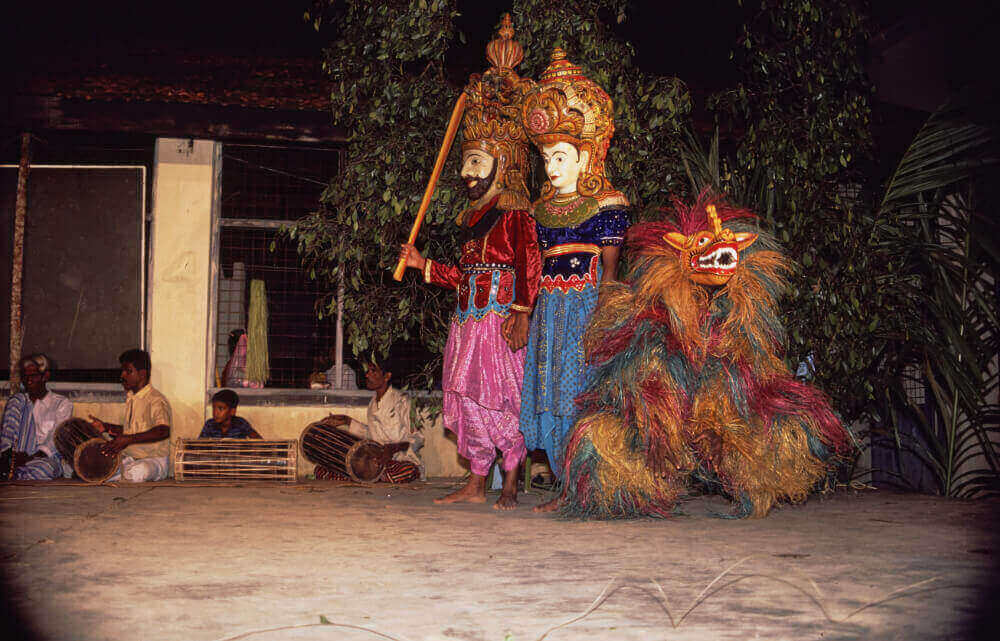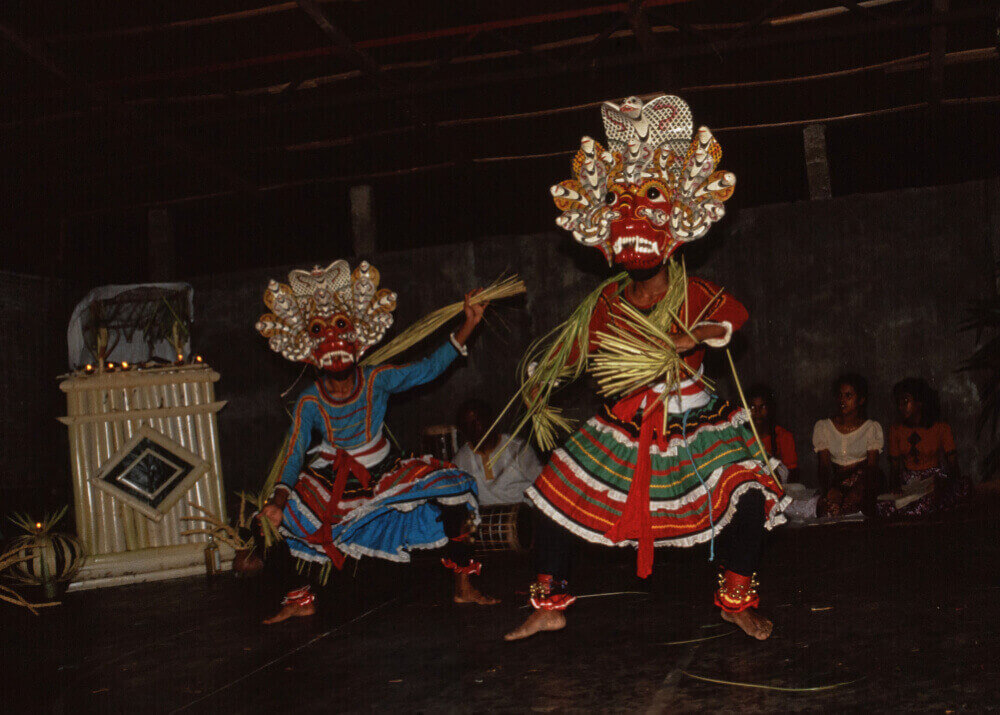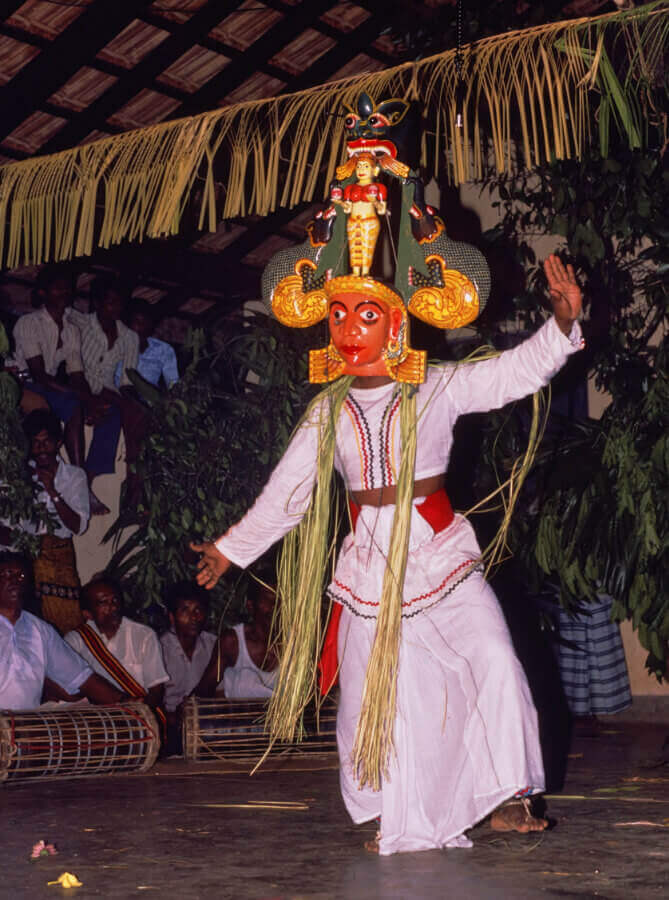The Kolam, a Folk Drama
by Wolfgang Mey
The Kolam, or Kolam Dances are a folk drama that was developed by the members of the fisher community on the south-west coast of Sri Lanka over several centuries.
It is still but rarely performed today. In the past the performances were spread over up to seven nights, in the late 20th century it was played for half a night, today a modernised version lasts about two to three hours.
- The majestic King and the Queen wearing large masks enjoy the acrobatic dance of a lion in a Kolam performance. Wolfgang Mey
The Performance
Kolam events take place on important dates in the Buddhist calendar, e.g. New Year.
For a Kolam event, a stage is prepared, and the audience sits on three sides of the stage. Two drummers accompany the performance with rhythms that match the characters the dancers represent. A director controls the performances, gives cues and leads the dialogue. The dancers used to belong to a close-knit family circle, but nowadays talented young people are also trained for individual roles in their spare time. In some cases, young women today play women’s roles that were earlier only played by men. Dialogues of the episodes are spoken by the male actors/dancers, invocations introducing the individual characters are recited by the master of the dialogues.
A Kolam event begins with invocations to the Buddha and the gods, from whom help for the event is requested. Then the explanatory story of the Kolam is recited to the audience in the introductory passages. The wife of the Great King was pregnant, she had a strong desire to see a masked dance. On the instructions of the King of Gods masks and lyrics for a performance were then provided. After the masked dance, the queen’s pregnancy problems disappeared.
- Naga Rakshayo perform a blessing dance for the King and the Queen. Wolfgang Mey
Following this introductory narrative, members of various professional groups come to announce the royal couple’s arrival, for instance the bodyguard that should ensure the safety of the royal visit. The royal couple comes to the stage and enjoys the acrobatic and elaborate dances of the lions and the Rakshayo. They are powerful beings whose dances and verses recited during their performances bring people happiness and relief.
Following the royal couple’s visit, various episodes from everyday life are staged. They depict the lives of the common people in the village, their dependence on the court officials, who plunder them by every trick in the book and gain many advantages for themselves. There are representatives of the colonial powers, e.g. the Portuguese, the Dutch and the British, who are all concerned about their economic advantages, have only profits in mind and are constantly on the lookout for beautiful women. At the end of the performance sequence from a Buddhist Jataka story is performed.
- In the end section of a Kolam performance a beatiful lady is cooling down the athmosphere by her pleasant dances. Wolfgang Mey
The large number of masks reflects the Sri Lankan world of the 19th and 20th centuries with its contradictions. Scenes in which the local and colonial authorities are ridiculed are “hot”. They are “cooled down” by the soft dances of beautiful women. At the end of the performance, the wild dance of the helpful and benevolent supernatural being (Gara Yaka) drives away all the evil influences that have contaminated the venue.
The Masks
Meaningful details are incorporated into the masks, the costumes are designed according to the same principle. The colours, the number of overlapping skirts, the colours and the patterns on the blouses allude to aspects and content of Buddhism and the world of the gods. However, the depictions of the masks are representations of the main stock types with their own iconographic details. These elements determine the position of the more complex masks in Buddhist cosmology.
- Mask dances have been adapted and modernised for cultural shows aimed for tourists and festivals abroad. Jukka O. Miettinen
The History and the Meaning
The Kolam dances and healing rituals were first reported by an Anglican priest at the beginning of the 19th century. Since then, new pieces have been added to the episodes staging court life in Kolam. The misdeeds of the colonial rulers were depicted. A small selection from the stories of the Buddha’s rebirths was added at the beginning of the 20th century. This gave Kolam a completely new direction, and while retaining all the comic, satirical and power-critical elements, the village theatre became a venue for the staging of fundamental Buddhist insights, too.
The episodes, in which social contradictions are depicted, are paraphrases of the Buddhist teaching on the cessation of suffering. The Kolam is a light-hearted, funny, and critical folk drama. It is, however, based on complex Buddhist insights, it is in fact a danced visualisation of its fundamental teachings.



